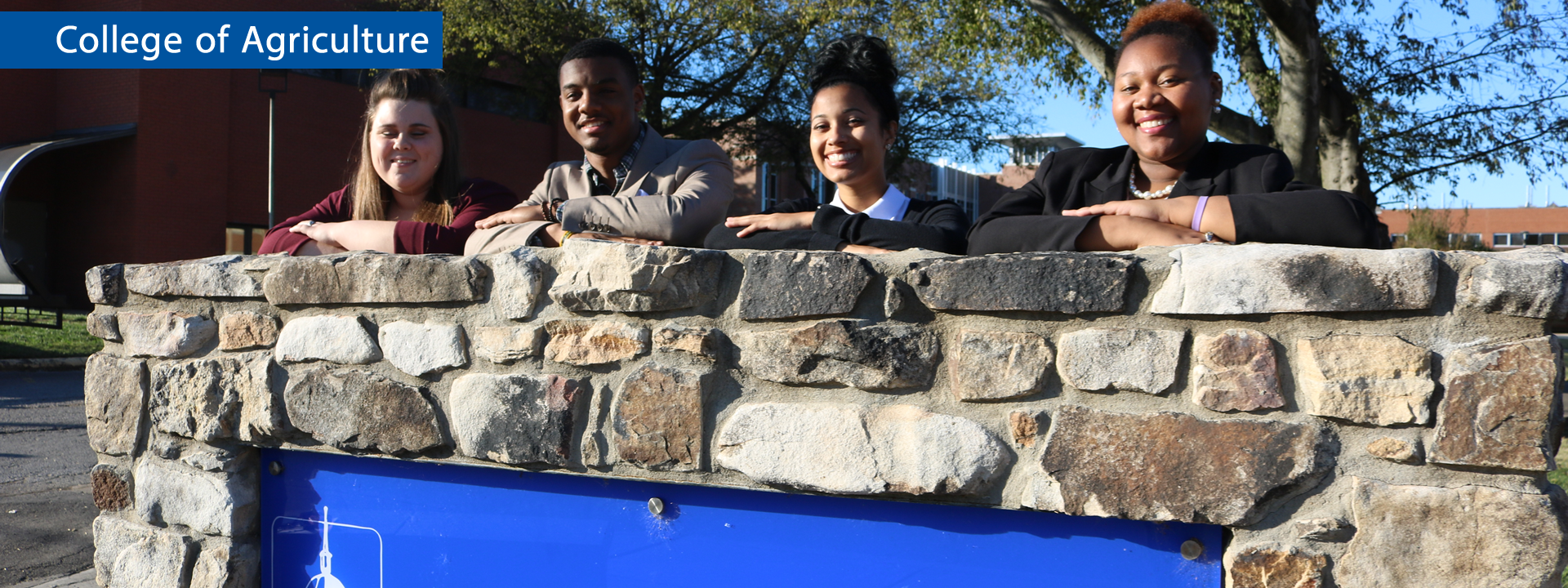- Home >
- College of Agriculture >
- Resumes
- > Sonali Roy
 Dr. Sonali Roy
Dr. Sonali Roy
Assistant Professor
Department of Agricultural Sciences and Engineering
College of Agriculture
Office Location: 103 Agricultural Biotechnology Building
www.legumegenetics.org
Email: sroy3@tnstate.edu
Twitter: @SonaliRoy_
ORCID: 0000-0002-8114-8300
Education and Training:
Postdoctoral Fellow Noble Research Institute, Ardmore, OK 2016 – 2020
PhD John Innes Centre, Norwich, UK (Legume Molecular Genetics) 2010 – 2014, 2015
MS Bose Institute, Kolkata, India (Plant Molecular Biology and Biotechnology) 2008-2010
BS University of Delhi, India (Botany) 2005-2008
Research Interests:
Plant roots are responsible for anchorage, nutrient and water uptake and occasionally nutrient storage. Interestingly, they also provide a surface for interactions with soil microbes. Legumes such as Medicago truncatula and its economically-important sister species Medicago sativa (Alfalfa) can associate with soil microbes such as rhizobia bacteria or arbuscular mycorrhizal fungi to form mutually beneficial relationships. In exchange for photosynthetically fixed carbon, these microbes provide nitrogen and phosphorus, that would normally not be available to plants; thus, saving farmers and the agricultural industry billions of dollars that would otherwise be invested into expensive, fossil fuel-based fertilizers.
In my lab, we use molecular genetic tools to understand the basis of these beneficial interactions and how plant roots help take up nitrogen from the environment. We study plant signals specifically peptide hormones to ask the questions
How can we reduce nitrogen-fertilizer dependency in agriculture without compromising overall plant fitness?
How do legumes integrate nutrient-signaling pathways and the symbiosis signaling pathway to acquire nitrogen from their environment?
Besides research, I train my mentees in science communication, research best practices and share my struggles (and victories) with maintaining a healthy work-life balance. I am always looking for interested graduate students to join our team. Contact me directly via email or twitter to ask about current and upcoming openings in the lab!
Publications:
Peer Reviewed Articles
Griffiths M., Roy S., Haichao Guo, Seethepalli A., Huhman D., Yaxin G., Sharp R.E, Fritschi F. B., York L.M, A multiple ion-uptake phenotyping platform reveals shared mechanisms that affect nutrient uptake by maize roots Plant Physiology, 2020 https://doi.org/10.1093/plphys/kiaa080
Boschiero C., Dai X., Lundquist PK., Roy S., de Bang TC., Zhuang Z., Zhang S., Torres-Jerez I., Udvardi MK, Scheible WR, Zhao P. (2020) MtSSPdb: The Medicago truncatula Small Secreted Peptide Database. Plant Physiology, 183(1), 399-413 https://doi.org/10.1104/pp.19.01088
Roy S.*, Liu W.*, Nandetey R., Crook A., Mysore K., Pislariu C., Frugoli, J., Dickstein R., Udvardi, M.K. (2020). Celebrating 20 years of genetic discoveries in legume nodulation and symbiotic nitrogen fixation. The Plant Cell, 32(1), 15-41. https://doi.org/10.1105/tpc.19.00279
Boschiero C.*, Lundquist P.K.*, Roy S.*, Dai X.*, Zhao P.X., and Scheible W.R. (2019). Identification and Functional Investigation of Genome‐Encoded, Small, Secreted Peptides in Plants. Current protocols in plant biology, 4(3), e20098. https://doi.org/10.1002/cppb.20098
Liu C., Breakspear A., Guan D., Cerri M., Abbs K., Robson F., Radhakrishnan G., Roy S., Bone C., Stacey N., Rogers C., Trick M., Niebel A., Oldroyd G. E., Carvalho-Niebel F., Murray J. D. (2019). NIN acts as a network hub controlling a growth module required for rhizobial infection. Plant Physiology, 179(4), 1704-1722. https://doi.org/10.1104/pp.18.01572
Roy S.*, Lundquist P.K.*, Udvardi M., Schieble W. (2018). Small and mighty: Peptide hormones in plant biology. Teaching Tools in Plant Biology: Lecture Notes. The Plant Cell (online), https://doi.org/10.1105/tpc.118.tt0718
Pfeilmeier S., George J., Morel A., Roy S., Smoker M., Stransfeld L., Downie J.A, Peeters N., Malone J., Zipfel C. (2019). Expression of the Arabidopsis thaliana immune receptor EFR in Medicago truncatula reduces infection by a root pathogenic bacterium, but not nitrogen‐fixing rhizobial symbiosis. Plant biotechnology journal, 17(3), 569-579. https://doi.org/10.1111/pbi.12999
de Bang T.C., Lundquist P.K., Dai X., Boschiero C., Zhuang Z., Pandey-Pant P., Torres-Jerez I., Roy S., Dickstein R., Udvardi MK, Zhao P, Scheible WR (2017). Genome-wide identification of Medicago peptides involved in macronutrient responses and nodulation. Plant Physiology, 175(4), 1669-1689 https://doi.org/10.1104/pp.17.01096
Roy S., Robson F., Lilley J.L.S., Liu C., Cheng X., Wen J., Bone C., Bennett M.J., Downie J.A., Swarup R., Oldroyd G.E.D., J. Murray (2017). MtLAX2, a functional homologue of the Arabidopsis auxin influx transporter AUX1, is required for nodule organogenesis. Plant Physiology, 174(1), 326-338. https://doi.org/10.1104/pp.16.01473
Liu C., Breakspear A., Roy S., and Murray J.D. (2015). Cytokinin responses counterpoint auxin signaling during rhizobial infection. Plant signaling & behavior, 10(6), e1019982. https://doi.org/10.1080/15592324.2015.1019982
Da-Song C., Liu C., Roy S., Stacey N., Cousins D., Murray J. D (2015). Identification of a core set of rhizobial infection genes using data from single cell-types. Frontiers in plant science, 6, 575. https://doi.org/10.3389/fpls.2015.00575
Breakspear A., Liu C., Roy S., Stacey N., Rogers C., Trick M., Morieri G., Mysore K.S., Wen J., Oldroyd G.E.D, Downie J.A., and Murray J.D. (2014). The root hair “infectome” of Medicago truncatula uncovers changes in cell cycle genes and reveals a requirement for auxin signaling in rhizobial infection. The Plant Cell, 26(12), 4680-4701. https://doi.org/10.1105/tpc.114.133496
Macho A. P., Schwessinger B., Ntoukakis V., Brutus A., Segonzac C., Roy S., Kadota Y., Oh M. H., Sklenar J., Derbyshire P., Lozano-Durán R., Malinovsky F. G., Monaghan J., Menke F. L., Huber S. C., He S. Y., Zipfel C. (2014). A bacterial tyrosine phosphatase inhibits plant pattern recognition receptor activation. Science, 343(6178), 1509-1512. https://doi.org/10.1126/science.1248849
Book Chapters:
Breakspear A., Liu C., Cousins D.R, Roy S., Guan D. and Murray J.D. “The role of hormones in rhizobial infection,” Biological Nitrogen Fixation Edited by Frans J. de Bruijn (2015).
Editorial Articles:
Roy, S. (2017). Time-Intensive transcriptomics reveal temporal patterns in the jasmonic acid gene regulatory network. The Plant Cell, 29(9), 2078-2079. https://doi.org/10.1105/tpc.17.00742
Roy, S. (2018). Goldilocks Principle: MtNFH1 ensures optimal nod factor activity. The Plant Cell. https://doi.org/10.1105/tpc.18.00114
Roy, S. (2018). Joseph J. Kieber. The Plant Cell. https://doi.org/10.1105/tpc.18.00110
Roy, S. (2018). Nitrate Ahoy! Shoot cytokinin signals integrate growth responses with nitrogen availability. The Plant Cell. https://doi.org/10.1105/tpc.18.00453
Roy, S. (2019). Roger W. Innes. The Plant Cell, 31(3), 555. https://doi.org/10.1105/tpc.19.00097
Roy, S. (2019). Solving a cold case: Identification of promoter elements to complement Medicago nin mutants. The Plant Cell, tpc. 00019.02019. https://doi.org/10.1105/tpc.19.00019
Scientific Blog Posts:
Schwessinger B., Roy S., Ganguly D., Elife, (2019) Levelling Up: Reproducibility for Everyone https://elifesciences.org/inside-elife/88ffb4ed/levelling-up-reproducibility-for-everyone
Roy S., Experimental Reproducibility 101, Plantae, (2018). https://plantae.org/experimental-reproducibility-101-part-1/
Roy S., Three Important Lessons We Learned from Medicago in 2017, (2018) https://www.noble.org/blog/threeimportant-lessons-we-learned-from-medicago-in-2017/
Roy S., Top 5 Resources for Medicago Researchers, (2017). https://www.noble.org/blog/top-5-medicago-resources/
Invited Talks and Conference Presentations:
Invited Seminar – Queen’s University, University of Warwick, Tennessee State University, McGill University Regulation of nitrogen acquisition by peptide hormones. (2020)
Parallel Session – Interaction of Symbiosis with Hormones, GOLVEN peptides control lateral root and nodule organogenetic programs in Medicago truncatula, International congress of Nitrogen Fixation, Wuhan, China. (2019)
Concurrent Session – Symbiosis and Mutualism, “Making a nodule – A role for MtLAX2” XVII Congress on Molecular Plant-Microbe Interactions, Portland, USA. (2016)
Young Scientist Award Session, Medicago truncatula MtLAX2, an orthologue of the AtAUX1 auxin influx transporter, mediates auxin control of nodule organogenesis, Society for Experimental Biology Annual Meeting, Prague, Czech Republic. (2015)
Lightening talk, Three ABC B-family transporters are important for root legume symbiosis, ABC Transporter Meeting, Chester, United Kingdom, (2015)
Workshop Oral Presentations:
Running a Research Group in the Next Generation, International Conference on Arabidopsis Research, Seattle, USA, 2021
Reproducibility for Everyone, American Society of Plant Biologists Annual meeting, Montreal, Quebec, Canada, 2018
Co-organizer, Introduction to the Transcriptome and Transcriptomics, National Science Foundation and Noble Research Institute, Plant OMICs Workshop, Ardmore, USA, 2018
Peptide Hormones in Nodulation, Noble Medicago Workshop, Ardmore, USA, 2018, 2019, 2020
Session Chair and presenter, Riding the tide of Peptides, Noble Plant Microbe Symposium, 2017
“Making a nodule – A role for MtLAX2,” John Innes Centre, Legume Workshop, Norwich, UK, 2015
Appointments:
International Society of Molecular Plant Microbe Interactions, Ambassador Nov 2020 – Present
Court Appointed Special Advocate of Southern Oklahoma Aug 2016 – 2020
Navjyoti India Foundation Dec 2015
Date Joined Faculty: 2021


